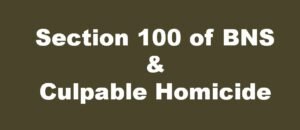Section 100 of BNS | Culpable Homicide | Bail Provisions
Section 100 of BNS defines culpable homicide as causing death with intention or knowledge that the act is likely to cause death.
Section 100 of BNS, 2023
Definition of Section 100 BNS
Section 100 of the Bharatiya Nyaya Sanhita, 2023 defines culpable homicide. A person commits culpable homicide when he causes death by doing an act—
- with the intention to cause death, or
- with the intention to cause such bodily injury as is likely to cause death, or
- with the knowledge that his act is likely to cause death.
When a person acts with such intention or knowledge and death results, the law treats his act as culpable homicide.
Illustrations
(a) A lays sticks and turf over a pit intending or knowing that death will probably result.
Z walks over it, falls in, and dies.
A commits culpable homicide.
(b) A knows Z is behind a bush; B does not know it.
A, intending or knowing that death will likely result, induces B to fire at the bush.
B fires and kills Z.
B may not be guilty, but A commits culpable homicide.
(c) A shoots at a fowl intending to kill and steal it.
His shot accidentally kills B behind a bush.
A did not know B was there.
Although A committed an unlawful act, he does not commit culpable homicide because he lacked intention or knowledge of likely death.
Explanations
Explanation 1:
When a person causes bodily injury to another who suffers from a disease or bodily infirmity and that injury accelerates the other’s death, the person causes death.
Illustration 2:
When death results from a bodily injury, the person who caused the injury causes the death, even if timely or skilful medical treatment could have prevented it.
Explanation 3:
Causing the death of a child in the mother’s womb does not amount to homicide.
However, if any part of the child is brought forth alive, even if it has not breathed or been completely born, causing its death may amount to culpable homicide.
Scope under Section 100 BNS, 2023
Section 100 of BNS covers all acts where a person intentionally or knowingly causes death or performs an act likely to cause death.
The section distinguishes culpable homicide from accidental or unintentional deaths and defines the mental element (mens rea) required to establish criminal liability.
A person who performs an act without intention or knowledge of likely death does not commit culpable homicide, even if the act itself is unlawful.
Bail Provision under Section 100 of BNS, 2023
An accused facing a complaint or FIR for culpable homicide may apply for anticipatory bail before arrest under criminal procedure provisions.
Courts evaluate intention, knowledge, and circumstances to decide bail requests in culpable homicide cases.
Summary
Section 100 of BNS (the Bharatiya Nyaya Sanhita, 2023) holds a person criminally responsible when his intentional or knowing act causes death.
The section’s illustrations and explanations clarify when the act becomes culpable homicide, when it remains accidental, and how bodily injury or childbirth circumstances affect liability.
Frequently Asked Question on Section 100 of BNS
What does Section 100 of BNS define?
Section 100 of BNS defines culpable homicide as causing death with intention or knowledge likely to cause death.
When does a person commit culpable homicide under Section 100?
A person commits culpable homicide when he intentionally causes death or bodily injury likely to cause death.
What knowledge is required to constitute culpable homicide?
The offender must know that his act is likely to cause death or such bodily injury leading to death.
What does Explanation 1 of Section 100 state?
It states that causing injury accelerating death of a diseased or infirm person amounts to causing his death.
What does Explanation 2 of Section 100 clarify?
It clarifies that death is caused even if proper medical treatment could have prevented it.
What does Explanation 3 of Section 100 explain?
It explains that causing a child’s death in the womb is not homicide but may become culpable homicide if partly born.
What does Illustration (a) of Section 100 show?
It shows that laying a trap causing another’s death constitutes culpable homicide under Section 100.
What does Illustration (b) of Section 100 demonstrate?
It demonstrates that inducing another to fire knowingly causing death amounts to culpable homicide.
What does Illustration (c) of Section 100 clarify?
It clarifies that killing without intention or knowledge, even during an unlawful act, is not culpable homicide.
Can an accused seek anticipatory bail under Section 100 of BNS?
Yes, the accused can seek anticipatory bail if a complaint or FIR for culpable homicide is filed.

